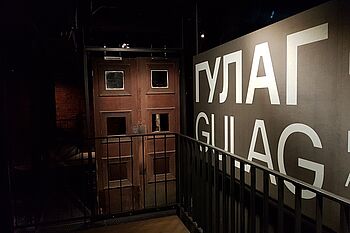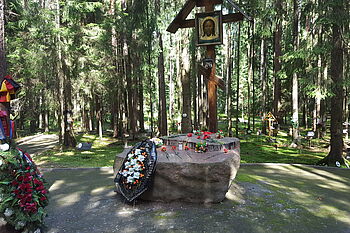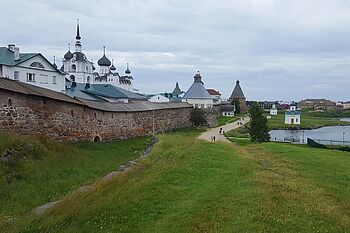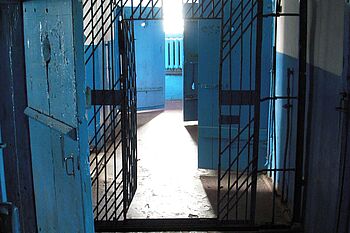The cell doors in the Moscow Gulag Museum were gathered from all over Russia. The number of former camps and prisons runs into the thousands. Although communist crimes are rarely a topic of public discussion, numerous memorial sites were established throughout this vast country. Many exist thanks to the work of the human rights organization Memorial.
Credit: Hubertus Knabe
Gulag Museum in Moscow

Credit: Hubertus Knabe
The huge letters at the entrance to the Moscow Gulag Museum stand for one of the largest camp systems in the world: The Soviet Chief Administration of Corrective Labor Camps and Colonies (GULag) that operated nearly 500 camp complexes with thousands of individual camps. Some 18 million people were imprisoned in them and at least 1.6 million of prisoners died. The museum, funded by the city of Moscow, tells their story in an ambitious permanent exhibition that opened in 2018 and is presented in two languages.
The “Gulag Archipelago,” the name the Russian Nobel Prize winner for literature Alexander Solzhenitsyn used to refer to the system of camps scattered throughout the country, became known worldwide through his book of the same name. Yet no one can say exactly how many people were imprisoned there or how many inmates died. Estimates put the number of dead at as high as six million. Based on official statistics, the Gulag Museum estimates that more than two million people died in the Gulag from hunger or disease.
For Stalin, the labor camps served as a central element of terror and a tool for securing his power. In the end, almost 450,000 people were required to run the Gulag, including over 230,000 guards. A second camp system was established in the 1940s and 1950s, containing another four to six million forced laborers and run by the Central Administration for Affairs of Prisoners of War and Internees (GUPWI). In total, some 30 million people were forced to perform forced labor in the Soviet Union.
The camps, however, were also an important economic factor, especially for large construction sites and for the development of raw material deposits in inhospitable regions. Diamonds, platinum and uranium, for example, were mined exclusively by prisoners in the early 1950s; prisoner labor accounted for about half of all timber and coal mining. Several large-scale projects, such as the White Sea Canal or the first nuclear power plant near Chelyabinsk, were also the work of tens of thousands of prisoners. Several Russian railroads, streets and even entire cities, such as Magadan and Norilsk, were literally built on human bones.
The State Museum of the History of the Gulag devotes an ambitious exhibition to this camp system. The former Gulag prisoner, historian and Stalin biographer Antonov-Ovsejenko, founded the museum in 2001 and opened it in 2004. In 2012, his deputy Roman Romanov took over as director. Three years later, the museum moved to a historic building located about three kilometers from Red Square. The four-story structure was completely refurbished to accommodate the museum. It opened in 2018 with a new permanent exhibition in Russian and English that also offers a multilingual audio guide. The museum is run by the Moscow City Department of Culture.
The exhibition begins with sixteen doors from prisons and other state institutions symbolizing the once top-secret world of repression. The exhibition also addresses early persecution measures carried out after the Bolsheviks seized power. The sprawling connections between their ideological ideas and political practice are presented like a spider’s web.
The main section of the exhibition focuses on the history of the Gulag. It describes the origins of “re-education through labor,” the various waves of repression and the system of extrajudicial sentences. Many objects are on display to illustrate the Soviet system of forced labor. Information is also provided on the high mortality rate and fates of imprisoned children. Individual prisoners are also introduced as examples throughout the exhibition. In one area, the names of 3.5 million Gulag prisoners are read out loud, a process that takes more than two years to complete. A few camps are shown in their present condition. The exhibition, however, addresses neither the role nor the views of those responsible. Nor does it examine any existing continuities within the Russian state and security apparatus today.
The museum also runs a documentation center with a database of all Soviet labor camps. It maintains a collection of video interviews with Gulag survivors, guards and relatives and owns a large collection of historical objects and memorabilia. A small mobile exhibition developed for use in schools presents various objects that, when touched, are explained on a screen by a contemporary witness. In addition, the museum regularly conducts excursions to former camp sites and maintains contact with local remembrance initiatives.
The creation of the museum fulfills a long-standing demand of the human rights organization Memorial. Some, however, see it as an attempt to nationalize the process of coming to terms with Stalinism and undermine the work of civic initiatives.
Links
Website of the Gulag History Museum
Virtual Museum of the Gulag of the human rights organization Memorial
Website of the human rights organization Memorial
After the Dictatorship. Instruments of Transitional Justice in Former Authoritarian Systems – An International Comparison
A project at the Department of Modern History at the University of Würzburg
Twitter: @afterdictatorship
Instagram: After the dictatorship
With financial support from the German Federal Ministry for Economic Cooperation and Development
Levashovo Memorial Cemetery

Credit: Hubertus Knabe
An oppressive silence hovers over the spruce forest of Levashovo. Here on the outskirts of St. Petersburg lie the remains of up to 45,000 executed people. They were shot by the Soviet secret police and buried in nameless mass graves. Members of the human rights organization Memorial discovered the KGB-guarded burial ground in 1989 and achieved having it declared a memorial cemetery. For many relatives, the trees are a substitute for gravestones.
The Soviet secret police sealed off the site near the Levashovo railroad station in the summer of 1937 so that it could be used as a mass grave. Within a few months, some 24,000 dead were buried here. Most had been shot in the basement of the People's Commissariat for Internal Affairs (NKVD) in Leningrad (today: Saint Petersburg).
It is estimated that up to 45,000 bodies were buried at the site. The exact number is not known because the names of the dead were not recorded at the time of their burial. But historians assume that a large number of the people executed by the Leningrad NKVD found their final resting place here. The execution lists make it possible to draw conclusions about who is likely to have been buried at this site.
The victims include several prominent Russian scientists and intellectuals, such as the physicist Matvei Bronstein and the poet Boris Kornilov. However, in the course of the so-called national operations, numerous members of non-Russian nationalities were also shot, including over two dozen German communists living in Leningrad. Most of the members of the Bolshevik Party leadership, who were arrested, tortured and executed from 1949 onward, are also believed to be buried here. The last bodies were most likely brought here in 1954.
In 1965, the Leningrad Committee for State Security (KGB) abandoned the burial site that had been disguised as a military object. It continued to be closely guarded however. The KGB also restored the three-meter-high fence, filled the sunken graves with sand and planted trees. Based on witness testimony, Memorial members were able to identify the burial ground in 1989. Excavations were subsequently conducted during which numerous mass graves were discovered at the center and northern edge of the site. Similar secret burial grounds were also found on the outskirts of Moscow (Butovo-Poligon and Kommunarka) and in northern Russian Karelia (Sandarmorch and Krasny Bor).
In 1989 the city of Leningrad declared the site near Levashovo a memorial cemetery for victims of political repression. The KGB handed it over to the city and a group of architects developed a new design concept. Several paths were laid between the trees; a map of the site and church bell were placed at the entrance. A simple exhibition is presented in the former blockhouse that had been used by the guards. The Russian Orthodox Church recently built a wooden chapel on the road leading to the site.
Relatives have gradually transformed the forest into a cemetery. Trees are adorned with small enameled pictures of the people buried here. Crosses, gravestones and entire memorial installations have also been erected among the spruces. The Berlin communist Anna Tieke is commemorated by a black gravestone. She emigrated to the Soviet Union in 1931 and was shot in 1938 at the age of 40, along with her son Rudolf.
Solovetski Prison Island

Credit: Hubertus Knabe
The white onion domes rise elegantly behind the thick fieldstone defensive wall. At first glance, one would not suspect that the Soviet Gulags originated here, in a centuries-old monastery on an island in the White Sea. The Bolsheviks established their first labor camp, the Solovetski Special-Purpose Camp (SLON), at the northernmost outpost of the Russian Orthodox Church.
Almost everyone in Russia is familiar with the Solovetsky Islands, often affectionately called “Solovki.” The 600-year-old men's monastery located here is depicted on the 500-ruble bill. For many, the remote island, located about 160 kilometers south of the Arctic Circle, is a place of religious contemplation; for others it is a symbol of the brutality of communism.
It is probably due to its remote location that the monastery served since the 16th century as a state prison. Following the Bolshevik seizure of power, it was converted into a state farm (sovkhoz) and in 1923 placed under the control of the secret police. It was at that time that the Soviet government decided to establish a large labor camp on the island. Thousands of prisoners were shipped here, mostly from prisons in Moscow and Petrograd. The quarantine station for the new arrivals was located in the Trinity Cathedral; the “negative elements” were housed in the refectory. In the end, it contained six convict units with up to 50,000 prisoners.
In the beginning, most of the prisoners sent to the prison island were “alumni” – the term used by the Bolsheviks to refer to the old Russian elite. The detainees included more than 80 metropolitans, bishops and archbishops, and over 400 priests. Numerous noblemen, officers, scientists and artists were also sent there to be “re-educated” through work. The writer Alexander Solzhenitsyn called the camp the “Mother of the Gulag” because this was where the Soviet system of forced labor was tested on a large scale for the first time.
One prisoner is regarded as the inventor of socialist slave labor: Naftali Frenkel, who made a career in “prisoner self-administration” and later held leading positions in the Gulag administration. It was his idea to link food rations to work performance. Prisoners dressed in utterly inadequate clothing were forced to cut wood even in freezing temperatures. Violations of the strict regulations were met with draconian punitive measures. In winter, prisoners dressed only in their underwear were placed in an icy punishment cell; in summer, they were shackled and exposed to swarms of mosquitoes or pushed down a steep staircase on Sekirnaya Hill. This led to thousands of deaths; the exact numbers were not recorded.
In 1929, after the first reports of escaped prisoners had reached the West, the government sent the writer Maxim Gorky to the island. After his visit, he wrote an enthusiastic essay about camp life and the methods of socialist re-education. In contrast, six weeks earlier, an inspection had taken place during which conditions so terrible were recorded that it led to the execution of one-third of the officers in the camp administration.
In 1931, most of the prisoners were dispatched to work on construction of the White Sea Canal. At least 25,000 of the approximately 170,000 prisoners who were deployed to the project died. Then, in 1937, as part of the “Great Terror,” nearly 2,000 prisoners on the island were selected for execution. Afterwards, with most of the natural resources depleted, the labor camp was closed. The monastery continued to serve as a special prison until the Northern Fleet took it over in 1939.
More than 50 years later, the Russian Orthodox Church decided to restore the monastery. The first monks returned in 1992. At Russia's request, UNSECO declared the ensemble a World Heritage Site. Ten years later, President Vladimir Putin, together with then Patriarch Alexei II, paid a ceremonial visit to the former prison island.
Little of the original camp is recognizable today. The monastery was elaborately restored and the hermitage on Sekirnaya Hill, the site of the punishment cell where the remains of 86 executed prisoners were found, has been returned to its former splendor. Only the prisoner barracks adjacent to the monastery, which now contain run-down apartments, a store and a museum, have been left almost entirely unaltered.
The small state museum presents the history of the camp with many photographs and documents. This is complemented by an exhibition in the monastery, in which the Russian Orthodox Church pays mostly tribute to Christian martyrs. The annual commemoration in August takes place between the barracks, in front of a large fieldstone, which members of Memorial brought to the site in 1989. The Church did not want a monument dedicated to Gulag victims on the monastery grounds.
Perm-36 Memorial Museum

Credit: Wulfstan
Sunlight shines like a glimmer of hope at the end of the cell corridor in the former Perm 36 camp. Members of the human rights organization Memorial discovered the empty prison in 1988 and turned it into a museum. But they were evicted in 2014 under false pretenses. The memorial is now run by the regional government. The history of the memorial, which has received international attention, shows the limits of coming to terms with the past in Russia.
The industrial city of Perm, once called the “gateway to Siberia,” is located in the foothills of the Urals, far from the rulers in Moscow or St. Petersburg. Its geographic location was one reason why Europe’s easternmost city, with a population of over a million, became a center of liberal culture after the end of communism. Back in the 2000s, local politicians also supported a citizens’ initiative to turn a former Soviet prison camp into a memorial.
The camp had been established in 1943 so that prison labor could be used to clear the surrounding forests. Three years later it moved to its present location, about 120 kilometers northeast of Perm (then: Molotov). The camp was given the designation ITK-6, which stood for Work Corrective Colony No. 6. As a consequence of its favorable location on a river, it was developed into a wood processing plant with its own sawmill. Because it contained technical equipment, it was not closed after Stalin's death in 1953, but instead declared a camp for “special purposes” - the only one in the Soviet Union.
The inmates were mostly imprisoned functionaries of the Soviet security organs, who were kept separate from other prisoners. Reinforced security measures, such as new alarm and signal systems, were added for this purpose. As of the early 1970s, dissidents and human rights activists were imprisoned here and forced to perform ten hours daily of forced labor. During this time, the camp was given the code name “VS-389/36,” which opposition circles abbreviated to “Perm 36.”
In the late 1970s a new wing was established in a somewhat remote barn. Here, prison conditions were even stricter than in the main camp - the so-called special regime. The fifty-six prisoners here were kept locked in their cells at all times because they had been convicted of “anti-Soviet agitation and propaganda" for the second or third time and were considered “particularly dangerous state criminals.” Seven prisoners - including the Ukrainian poet and human rights activist Vasyl Stus - died here and were buried in the camp cemetery. This was the only prison in the Soviet Union that held only political prisoners.
Several members of the Moscow Helsinki Group and the Soviet section of Amnesty International were among the camp’s prisoners. Representatives of the Kiev Helsinki Group and the Baltic independence movements were also sent to the maximum-security prison. One of the best-known inmates is Sergei Kovalev, who was sentenced to seven years in a labor camp in 1975 and in the early 1990s became chairman of the Government Commission on Human Rights. Former dissidents Yuri Orlov and Natan Sharansky, who were sentenced to seven and 13 years in a labor camp in 1978, are also well known, but they were held in Perm 35, a neighboring camp that still exists today.
Perm-36 is the only camp of the Gulag Archipelago that has been preserved in large parts. Many buildings date back to the Stalinist era, including a barracks for 250 prisoners, the infirmary, the toilet house and the so-called isolator – which was how the punishment cells were referred to in the Soviet Union. The kitchen building, built in 1972, an administration building, and part of the workshops and utility facilities are also preserved. Some of the buildings are now used for exhibitions and museum administration offices. In 2007, the former special prison was opened to visitors. Each summer, the memorial hosted the "Pilorama" (Sawmill) cultural festival with thousands of participants.
Following a change in the regional government in 2012, the association suddenly stopped receiving funding. The festival could also no longer take place. The memorial therefore accepted the offer to come under state sponsorship. But the subsidies provided by the state were not enough to cover the electricity bills and the museum’s power supply was cut off in 2014. The memorial had to close temporarily. A short time later, the regional government dismissed the founding director Tatyana Kursina and replaced her with an employee of the culture department. The association was declared a “foreign agent” and overrun with legal battles. After negotiations to jointly run the museum failed, the association dissolved in 2016.
The state takeover of the museum was accompanied by fierce political disputes. Former guards and conservative political forces accused the association of “falsifying history” in the media. The association countered that the new management was downplaying persecution in the Soviet Union. The room presenting the biographies of former dissidents had in fact been closed. Instead, new displays highlighted the prisoners' contribution to the Soviet Union's victory in World War II. This led many former prisoners to distance themselves from the museum, whose advisory board now includes former guards. Numerous Russians signed a petition to the Russian president protesting the changes.
The Human Rights Commission under the president finally ensured that a new museum concept would be developed. In coordination with the Russian Museum Association, the historian Julia Kantor was commissioned with this task in 2016. Heated arguments ensued between Kantor and representatives of the regional government about the museum’s orientation. Kantor was also accused by members of Memorial of having legitimized through her work the expulsion of the museum’s founders. In 2019, Kantor’s work was finished and the new concept was discussed at several conferences. The concept calls for a focus on the 1970s and on individual fates. It also proposes holding major events again and improving bus connections to the site.
Actual museum work, however, largely came to a standstill. Although a few smaller exhibitions were created and three plays were performed, visitor numbers dropped by about seventy percent. Contact with the former prisoners has broken off, but a scientific conference is still held every year. For many, Perm-36 is now above all a symbol of the Russian state’s crackdown on civil society initiatives.
Links
The Virtual Museum of the Gulag on the "Perm-36" Memorial Museum
Online exhibition of the former Memorial Museum "Perm-36"
Former website of the Memorial for the History of Political Repression "Perm-36" (Russian)
Website of the National Memorial for the History of Political Repression "Perm-36“ (Russian)
Report on the remains of the Stvor camp in the Perm region